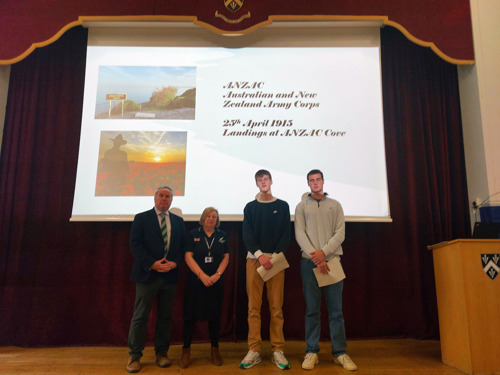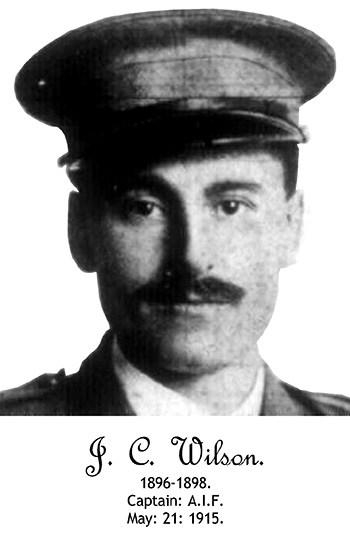Bloxham School observes Anzac Day

This year the staff and pupils of Bloxham School in Oxfordshire broke new ground in observing Anzac Day, its origins and significance.
The school’s Academic Lead, Dr Laurie Earl, a dual national who lived in New Zealand for 21 years, put together a school assembly during which she explained the historical context behind Anzac Day; she recounted a moving personal remembrance of attending the Dawn Service in Gallipoli and ended with the poem attributed to Ataturk of the Unknown Soldier.
The stories of three former pupils of the school who perished in the Great War, including one at Gallipoli, were delivered by two pupils of New Zealand descent, Toby Roach and Lewis Robinson and the School Archivist, Simon Batten, a member of the Gallipoli Association.
Captain John Wilson of the 1st Australian Imperial Force died on 21 May 1915 of wounds suffered at Gallipoli, while Driver Maurice (Bill) Adams of the 5th New Zealand Artillery was killed in action at Messines on 25 May 1917 and Private Charles Hammill (1st/4th Australian Infantry) was killed in action on 18 September 1918 at Hargicourt.
On Anzac Day itself, prayers were said in the school chapel for the three Old Bloxhamists and the Last Post was played, while the school’s catering students made Anzac biscuits. Dr Earl reported that she felt very proud of the school embracing the Anzac story and commemorating their Anzac former pupils. Simon Batten commented that this was a great opportunity to explain to students at a U.K. school the historic significance of Anzac Day and to remind them of the contribution of British Empire troops to the allied war effort. Toby and Lewis agreed that taking part reinforced their pride in their New Zealand heritage.
Captain John Wilson

John Carandini Wilson was born in Brisbane on 5 January 1882. His maternal grandparents were Girolamo Carandini, 10th Marquis of Sarzano, an Italian political refugee, and the opera singer Marie Carandini, who had emigrated to Australia with her parents and enjoyed an illustrious career in bel canto opera in Melbourne and Sydney. One of John’s cousins was the distinguished British actor Sir Christopher Lee, who also had Carandini as one of his forenames.
John worked as a journalist on the Sydney Mail alongside Charles Bean before the war. He joined up in September 1914, joining the 1st Australian Imperial Force as a Second Lieutenant.
Thanks to his previous service in the South African War, John Wilson was promoted to Captain in October 914. He took part in the landing at Anzac Cove on 25 April 1915, his battalion coming ashore in the second and third waves.
On the following night the 3rd Battalion was committed to the firing line on MacLaurin’s Hill, and a half-company under Wilson was put in to strengthen the line of the 11th Battalion at Courtney’s Post. According to Charles Bean, Wilson was observing through field glasses in a trench forward of Quinn’s Post while trying to find out who was on their right flank when he was hit. He lay in the trench for 30 hours before he was taken out and sent back to Egypt for treatment.
The Australian press reported that ‘Capt. John Carandini Wilson, reported dangerously wounded, had a most adventurous career’. He died of the effects of wounds received, recorded as being a perforating wound of the scalp from a gunshot, on 21 May 1915 in No. 17 General Hospital at Alexandria. He was buried at Chatby Cemetery, Alexandria, by Reverend A. V. C. Henderson. On 5 November 1915 he was mentioned in Despatches in the London Gazette.
His family did not inform his old school of John’s death, and his name was only added to the war memorial in Bloxham School’s chapel in 2014 thanks to research carried out by the historian Matthew Dixon.
